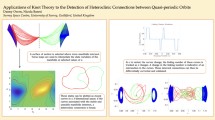Abstract
We consider the problem of the applicability of KAM theorem to a realistic problem of three bodies. In the framework of the averaged dynamics over the fast angles for the Sun–Jupiter–Saturn system we can prove the perpetual stability of the orbit. The proof is based on semi-numerical algorithms requiring both explicit algebraic manipulations of series and analytical estimates. The proof is made rigorous by using interval arithmetics in order to control the numerical errors.
Similar content being viewed by others
References
Abu-El-Ata, N. and Chapront, J.: 1975, ‘Développements analytiques de l'inverse de la distance en mécanique céleste', Astr. Astrophys. 38, 57–66.
Arnold, V. I.: 1963, ‘Proof of a theorem of A. N. Kolmogorov on the invariance of quasiperiodic motions under small perturbations of the Hamiltonian', Usp. Mat. Nauk 18, 13; Russ. Math. Surv. 18, 9–36.
Arnold, V. I.: 1963, ‘Small denominators and problems of stability of motion in classical and celestial mechanics'. Usp. Math. Nauk 18(6), 91; Russ. Math. Surv. 18(6), 85.
Arnold, V. I.: 1978, Mathematical Methods of Classical Mechanics, Springer-Verlag, New York.
Celletti, A. and Chierchia, L.: 1997, ‘On the stability of realistic three-body problems', Comm. Math. Phys. 186(2), 413–449.
Celletti, A., Giorgilli, A. and Locatelli, U.: 2000, ‘Improved estimates on the existence of invariant tori for Hamiltonian systems', Nonlinearity 13, 397–412.
Giorgilli, A.: 1965, ‘Quantitative Methods in Classical Perturbation Theory', in: A. E. Roy and B. D. Steves (eds), ‘Proceedings of the Nato ASI school’ From Newton to Chaos: Modern Techniques for Understanding and Coping with Chaos in N-body Dynamical Systems', Plenum Press, New York.
Giorgilli, A., Delshams, A., Fontich, E., Galgani, L. and Simó, C.: 1989, Effective stability for a Hamiltonian system near an elliptic equilibrium point, with an application to the restricted three-body problem, J. Diff. Eq. 77, 167–198.
Giorgilli, A. and Locatelli, U.: 1997, ‘Kolmogorov theorem and classical perturbation theory', J. App. Math. Phys. (ZAMP) 48, 220–261.
Gröbner, W.: 1973, Die Lie-Reihen und Ihre Anwendungen, Springer Verlag, Berlin (1960) (it. transl.: 1973, Le serie di Lie e le loro applicazioni, Cremonese, Roma.
Henon, M.: 1966, ‘Exploration numérique du problème restreint IV:Masses égales, orbites non p´eriodiques', Bull. Astronomique 3(1), fasc. 2, 49–66.
Henrard, J.: 2000, ‘A note on a general algorithm for two-body expansions', Celest. Mech. & Dyn. Astr. 76, 283–289.
Koch, H., Schenkel, A. and Wittwer, P.: 1996, ‘Computer-assisted proofs in analysis and programming in logic: a case study', SIAM Rev. 38(4), 565–604.
Kolmogorov, A. N.: 1954, ‘Preservation of conditionally periodic movements with small change in the Hamilton function', Dokl. Akad. Nauk SSSR 98, 527–530. (English translation in Casati, G. and Ford, J. (eds): 1979, Lecture Notes in Physics, N. 93, 51–56).
Laskar, J.: 1988, ‘Secular evolution over 10 million years', Astr. Astrophys. 198, 341–362.
Laskar, J.: 1989, Les variables de Poincaré et le développement de la fonction perturbatrice, Groupe de travail sur la lecture des Méthodes nouvelles de la Mécanique Céleste, Notes scientifiques et techniques du Bureau des Longitudes S026.
Laskar, J.: 1994, ‘Large scale chaos in the solar system', Astr. Astrophys. 287, L9-L12.
Laskar, J.: 1995, ‘Frequency map analysis of an Hamiltonian system', Workshop on Non-Linear Dynamics in Particle Accelerators, AIP Conf. Proc. 344, 130–159.
Laskar, J.: 1999, ‘Introduction to Frequency Map Analysis', in: C. Simó (ed.), Proceedings of the NATO ASI school: 'Hamiltonian Systems with Three or More Degrees of Freedom', S'Agaro (Spain), June 19–30, 1995, Kluwer, pp. 134–150.
Laskar, J. and Robutel, P.: 1995, ‘Stability of the planetary three-body problem-I. expansion of the planetary hamiltonian', Celest. Mech. & Dyn. Astr. 62, 193–217.
Locatelli, U.: 1998, ‘Three-body planetary problem: study of KAM stability for the secular part of the Hamiltonian', Planet. Space Sci. 46(11/12), 1453–1464.
Locatelli, U.: 2001, ‘Proof of a KAM theorem on the existence of invariant tori near an elliptic equilibrium point', Quaderni del dipartimento di matematica, Universitá di Milano, 5/2001.
MacKay, R. S. and Stark, J.: 1992, ‘Locally most robust circles and boundary circles for areapreserving maps', Nonlinearity 5, 867–888.
Moser, J.: 1962, ‘On invariant curves of area-preserving mappings of an annulus', Nachr. Akad. Wiss. Gött, II Math. Phys. Kl 1962, 1–20.
Moser, J.: 1967, ‘Convergent series expansions for quasi-periodic motions', Math. Ann. 169, 136–176.
Moser, J.: 1973, Stable and Random Motions in Dynamical Systems, Princeton University press, Princeton.
Murray, N. and Holman, M.: 1999, ‘The origin of chaos in outer solar system', Science 283, Iss. 5409, 1877.
Nobili, A. M., Milani, A. and Carpino, M.: 1989, ‘Fundamental frequencies and small divisors in the orbits of the outer planets', Astr. Astrophys. 210, 313–336.
Poincaré, H.: 1892, Les méthodes nouvelles de la Mécanique Céleste, Gauthier-Villars, Paris (reprinted by Blanchard (1987)).
Robutel, P.: 1993, Contribution á l'étude de la stabilité du problème planetaire des trois corps, Ph.D. thesis, Observatoire de Paris.
Robutel, P.: 1995, ‘Stability of the planetary three-body Problem-II. KAM theory and existence of quasiperiodic motions', Celest. Mech. & Dyn. Astr. 62, 219–261.
Schenkel, A., Wehr, J. and Wittwer, P.: 2000, ‘Computer-assisted proofs for fixed point problems in Sobolev Spaces', MPEJ 6(3), 1–67.
Sussman, G. J. and Wisdom, J.: 1992, ‘Chaotic evolution of the solar system’, Science 241, 56–62.
Author information
Authors and Affiliations
Rights and permissions
About this article
Cite this article
Locatelli, U., Giorgilli, A. Invariant Tori in the Secular Motions of the Three-body Planetary Systems. Celestial Mechanics and Dynamical Astronomy 78, 47–74 (2000). https://doi.org/10.1023/A:1011139523256
Issue Date:
DOI: https://doi.org/10.1023/A:1011139523256




